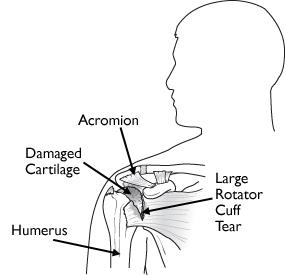Rotator Cuff Tear Arthropathy
Arthritis can also develop after a large, long-standing rotator cuff tendon tear. The torn rotator cuff can no longer hold the head of the humerus in the glenoid socket, and the humerus can move upward and rub against the acromion. This can damage the surfaces of the bones, causing arthritis to develop.
The combination of a large rotator cuff tear and advanced arthritis can lead to severe pain and weakness, and the patient may not be able to lift the arm away from the side.
Reverse shoulder replacement
If nonoperative treatment is inadequate to relieve pain and increase function then surgical treatment is sometimes recommended. Rotator cuff arthropathy is different from the more common osteoarthritis in that it cannot by treated with a standard shoulder replacement. The preferred treatment is a reverse shoulder replacement, where the ball and socket are reversed (the ball is screwed into the socket side and the socket is placed in the humerus).

